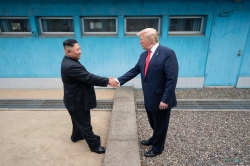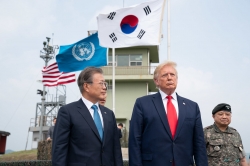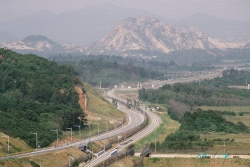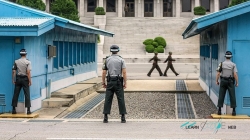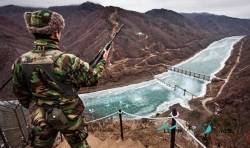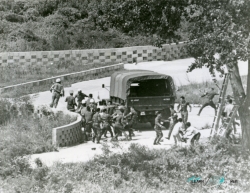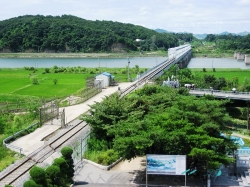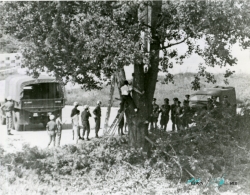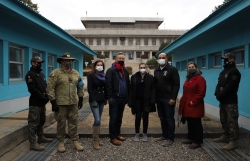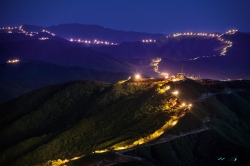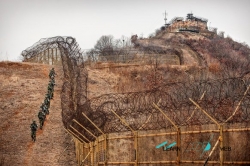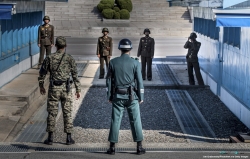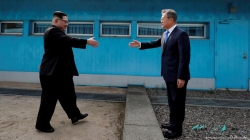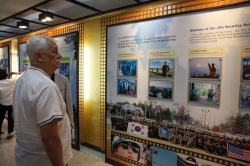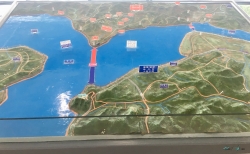The Korean Demilitarized Zone (Korean Demilitarized Zone, DMZ) is a demilitarized zone established in accordance with the armistice agreement signed in 1953 after the Korean War.
At the time of the signing of the Korean War Armistice Agreement that took effect on July 27, 1953, a total of 1,292 piles were driven from the Imjin River to the east coast, and an imaginary line of about 240 km connecting these piles was set as the Military Demarcation Line (MDL). The DMZ is set as a buffer zone to prevent military clashes in a range of 2 km from the Military Demarcation Line to the north and south.
Since the DMZ acts as a buffer against military clashes, any military action is prohibited. To enter the DMZ, you must obtain permission from the Military Armistice Commission, the number of people entering is partially limited, and carrying weapons is of course prohibited.
The Panmunjom area inside the DMZ is a special area. Both North and South Korea are guarded, and it is a circular area with a radius of about 400m centered on the Military Demarcation Line.
Based on the Military Demarcation Line (MDL), the boundary of the DMZ 2 km to the north is called the “Northern Limit Line” (NLL), and the boundary of the DMZ 2 km to the south is called the “Southern Limit Line” (SLL). There is an iron fence on the Northern and Southern Limit Lines, and the armies of the South and the North are facing each other.
Since 1963, as the North has built fortresses, fortifications, and iron fences, the demilitarized zone on the Korean Peninsula is disregarded as a demilitarized zone. A fence called 'propulsion fence' is installed between some GPs and GPs. The North calls themselves the 'Minkyungdae' and the South calls the 'Military Police' (DMZ Police), but in reality, both are armed soldiers.
As villages inhabited by civilians within the DMZ, there are Daeseong-dong in the south and Gijeong-dong in the north.
The natural ecosystem has been preserved as the activities of the general public are strictly prohibited in this area, and it is attracting attention as the largest nature conservation area in Asia. In addition, the DMZ area has the highest species diversity in Korea in terms of distribution of mammals and birds, which are the peak of the natural ecosystem, and has the largest number of natural monuments and endangered species such as black bear, fox, musk deer, goat, and otter. It is also a habitat for In addition, the rivers and wetlands around the DMZ are well developed, and various fish species and abundant populations are kept.
At the time of the signing of the Korean War Armistice Agreement that took effect on July 27, 1953, a total of 1,292 piles were driven from the Imjin River to the east coast, and an imaginary line of about 240 km connecting these piles was set as the Military Demarcation Line (MDL). The DMZ is set as a buffer zone to prevent military clashes in a range of 2 km from the Military Demarcation Line to the north and south.
Since the DMZ acts as a buffer against military clashes, any military action is prohibited. To enter the DMZ, you must obtain permission from the Military Armistice Commission, the number of people entering is partially limited, and carrying weapons is of course prohibited.
The Panmunjom area inside the DMZ is a special area. Both North and South Korea are guarded, and it is a circular area with a radius of about 400m centered on the Military Demarcation Line.
Based on the Military Demarcation Line (MDL), the boundary of the DMZ 2 km to the north is called the “Northern Limit Line” (NLL), and the boundary of the DMZ 2 km to the south is called the “Southern Limit Line” (SLL). There is an iron fence on the Northern and Southern Limit Lines, and the armies of the South and the North are facing each other.
Since 1963, as the North has built fortresses, fortifications, and iron fences, the demilitarized zone on the Korean Peninsula is disregarded as a demilitarized zone. A fence called 'propulsion fence' is installed between some GPs and GPs. The North calls themselves the 'Minkyungdae' and the South calls the 'Military Police' (DMZ Police), but in reality, both are armed soldiers.
As villages inhabited by civilians within the DMZ, there are Daeseong-dong in the south and Gijeong-dong in the north.
The natural ecosystem has been preserved as the activities of the general public are strictly prohibited in this area, and it is attracting attention as the largest nature conservation area in Asia. In addition, the DMZ area has the highest species diversity in Korea in terms of distribution of mammals and birds, which are the peak of the natural ecosystem, and has the largest number of natural monuments and endangered species such as black bear, fox, musk deer, goat, and otter. It is also a habitat for In addition, the rivers and wetlands around the DMZ are well developed, and various fish species and abundant populations are kept.



